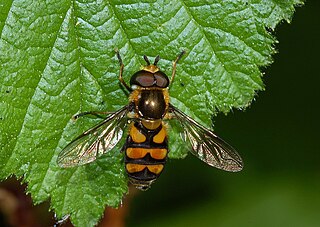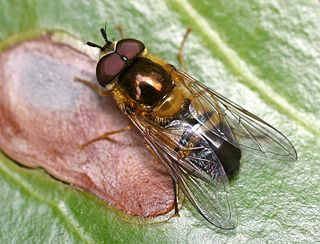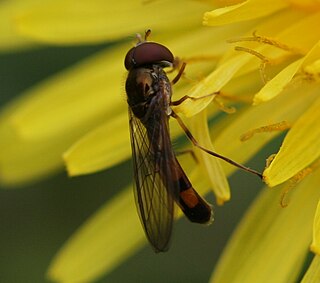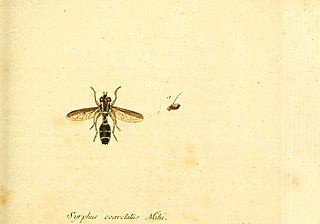
Leucozona glaucia, the Pale-saddled Leucozona is a Palearctic hoverfly. Larvae feed on ground layer aphids. Adults are usually seen visiting flowers.

Eupeodes luniger is a common species of hoverfly.

Didea fasciata is a Holarctic species of hoverfly.

Epistrophe eligans is a European species of hoverfly.

Leucozona laternaria is a European species of hoverfly.

Leucozona lucorum is a Palearctic and Nearctic species of hoverfly.

Melanostoma is a large genus of hoverflies. Little is known of their biology, but they are suspected to be general predators of small insects in leaf litter.

Melanostoma scalare, the chequered hoverfly, is a very common species of hoverfly.

Melanostoma mellinum is a very common species of hoverfly found in many parts of Britain, Europe including the Mediterranean basin and North Africa, the East Palearctic, and North America.

Baccha elongata is a species of hoverfly in the genus Baccha.

Platycheirus granditarsus, the Hornhand Sedgesitter, is a species of hoverfly. It is found in many parts of Britain North America and Europe. Typical habitat includes marshy meadows and ditches, where it can be found between May and October, though it is at its commonest between July and September. The most distinctive feature of this fly is the red-orange abdomen most easily seen as it takes off or alights.

Platycheirus manicatus is a species of hoverfly. It is found across the Palearctic and in Alaska.

Epistrophe grossulariae is a Holarctic species of hoverfly.

Platycheirus ambiguus is a small widespread species of hoverfly found across the Palearctic from Ireland to Japan. A spring species found in flight in April and May, it visits spring-flowering trees and shrubs, e.g., Prunus spinosa in deciduous woodland and scrub.
Platycheirus nielseni is a Holarctic species of hoverfly.

Doros profuges is a Palearctic species of hoverfly.

Epistrophe nitidicollis is a European and North American species of hoverfly.

Epistrophe melanostoma is a European species of hoverfly.
Epistrophe ochrostoma is a European species of hoverfly.
















